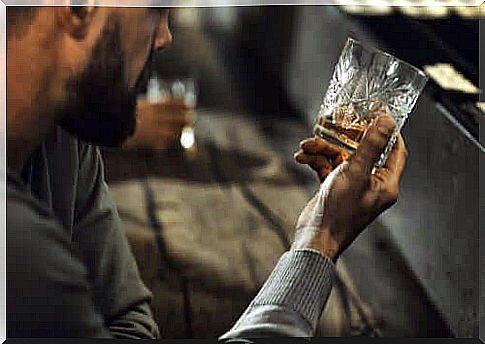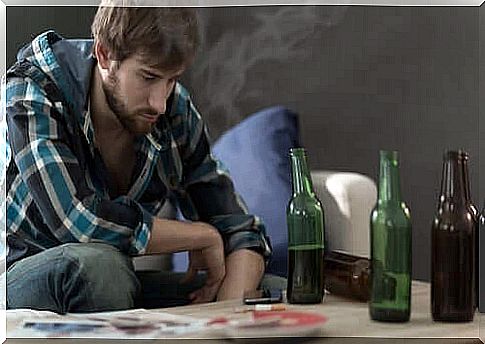Psychological Treatments For Alcoholism

Most psychological treatments for alcoholism are based on the cognitive behavioral model. This model treats this substance as a powerful reinforcement mechanism that maintains a person’s habit of using it for self-treatment. The cognitive behavioral model offers an alternative approach to the traditional one that assumes that alcoholism is a disease.
The ultimate goal of psychological treatments for alcoholism is to reduce a person’s preference for alcohol. At the same time, they aim to increase the preference for other activities, which makes it possible to maintain long-term adaptive function.
Depending on the patient, their personal resources and family environment, another goal may be to train them to just stop the problematic use of alcohol. Experts call this “controlled drinking”.
There are currently two major schools for intervention among psychological treatments for alcohol. The focus is on trying and achieving complete abstinence. The other aims to get the person to consume the drink in a safe and controlled way. We will describe each of these below.
The behavioral model aims to change the behavior directly related to alcohol consumption. This approach places the responsibility for the problem directly on the individual. As such, change lies solely in their hands.

Psychological treatments for alcoholism aimed at abstinence
Social skills or self-control training
Experts tend to use this for patients who lack sufficient expertise between people. It is also a good way to help those who cannot control their emotional state without the use of alcohol. Experts have observed that those who drink use less alcohol in stressful social situations if they have an alternative strategy for dealing with problems.
An example is the manual for Monti et. al (2002). This work provides social strategies both to the patient as well as to their support group. These allow the patient to avoid the need to drink alcohol.
Society-strengthening approach as one of the treatments for alcoholism
This approach tries to change the lifestyle associated with the consumption of the drug. This includes techniques such as problem solving, family behavior therapy, social counseling and job search training. You can also use this approach in conjunction with controlled drinking.
Psychological treatments for alcoholism: Marriage therapy
This involves going beyond the consumption of alcohol as a reinforcement mechanism and has abstinence as a goal. It tries to get the couple to participate in satisfying activities together. Activities that do not involve any kind of drinking are best.
Aversion therapy
The goal of these treatments is to reduce or eliminate a person’s desire for alcohol completely. Therapists who use these will use different stimuli or images. They use these in such a way that they provoke a negative response to the properties of alcohol (eg color, smell, etc.).
Experts have used various stimuli. These range from the classic electric shock that Kantarovich used in 1929 to chemical tools or even just visualization.
An example of this treatment is the covert sensitization method proposed by Cautela in 1970. Eight sessions tend to be sufficient to see results with this treatment.
Psychological treatments for alcoholism: Prevent relapse
The best known is Marlatt and Gordon’s theory. Here they place the bulk of the burden on the client as the one responsible for changing their behavior. In extension of this, they are also responsible for maintaining the change once they have achieved it.
Relapse prevention must take into account the fact that strategies for dealing with the problem must be stronger in high-risk situations.
Treatments for alcoholism that aim to achieve a normal drinking pattern
Experts choose these when the person does not want to stop drinking completely as they do not have physical problems. The most representative program from this group is Sobell & Sobell.
The Sobell & Sobell program aims to steer problem drinkers away from a chronic drinking problem. The basis is to teach them to control themselves. In this intervention, the individual must put many of the strategies the therapist teaches them into practice.
These tend to be young people with a high level of education. They are usually employed and have few serious episodes of alcohol consumption. Most of them have abused alcohol for a period of five to ten years. When it comes to personal social and economic resources, there is not much difference from the rest of the population. This means that they are in a good position to make important changes in life without too many obstacles.

The Sobell & Sobell program takes four weeks, and the expert administers it on an outpatient basis. It is not very intensive considering the work the patient does at the clinic, but it involves a lot of homework. Ultimately, it tries to get patients to make the change themselves.
Guidelines for Sobell & Sobell
These are some of the suggestions made in this program: do not consume more than three units of alcohol and do not drink more than three days a week. If you follow this rule, your tolerance for alcohol will be lower. In addition, you should never drink in high-risk situations, and you should not have more than one drink per hour. Another important piece of advice is to make sure that you wait at least 20 minutes between the time you decide to drink and the time you actually do it.
Training in problem solving and relapse prevention is very important in this program. This will help the patient to identify the situations in life that are associated with alcohol use. They can then use the strategies they learned to deal with these situations.
Conclusion
For both types of treatment for alcoholism that we discuss here, the ultimate goal is for the patient to learn alternative coping strategies. These strategies should serve to put a brake on the impulse to drink alcohol. These can be as simple as social techniques for learning to say “no” to people who encourage the person to drink. Another example is learning new ways to effectively solve the problems that the drinker is trying to solve by thinking.
The goal is to disconnect from the addiction and start on a new path. It is true that the process can be unpleasant. With focus, however, the patient can face any problem that arises.
In today’s age, psychological treatments for alcoholism are extremely important, especially those that focus on controlled drinking. This is because there has been a huge increase in young people choosing alcohol as a way to deal with their problems and emotions.
A major goal of all this is to succeed in stopping these young people from becoming pathological drinkers. Instead, it is much better for them to learn effective ways to manage their lives, free from alcohol consumption.








